Apps
Auto Added by WPeMatico
Auto Added by WPeMatico
A new messaging app is looking to give folks a way to communicate in situations with poor or no cellular connectivity.
Berkanan, founded by Zsombor Szabó, is a group messaging app that uses Bluetooth to send and receive messages. This means that Berkanan works in a plane, at a festival, camping, or anywhere else where cellular coverage is disappointing.
Imagine people on a plane asking each other for top movie recommendations from the in-flight entertainment system, or folks at a festival figuring out a rally point to meet up between sets. Public messages auto-delete after 24 hours.
Alongside group messaging, Berkanan also allows private one-to-one messaging, as well as audio calls placed over Bluetooth. The range for these calls and messages is about 50 meters, but if there are people between you and your intended recipient with the app installed, Berkanan can send messages further by going through other users devices.

Berkanan will also show users if they are getting closer or further away from the user they’re messaging with, without ever showing either person’s exact location.
Group chatting with strangers in your location might seem a bit icky at first glance, but group chatting with strangers is essentially the basis of Twitter. With Berkanan, however, a common location replaces the #topic.
Berkanan is entirely bootstrapped, but Szabo has implemented a somewhat unconventional method of generating revenue.
Inspired by games like Fortnite, which make money off of custom skins, dances, and other virtual items, Berkanan will charge users to edit their profile. When a user logs on, their profile will consist of the name they assigned to their iPhone and their profile picture will be their initials, similar to the iOS Contacts interface.
Users can pay to add their own profile picture and add a short bio to their profile.
To be clear, it’s already possible to send SMS via Bluetooth. But Berkanan offers a way to broadcast that message to everyone (with the app) in your location. Of course, user acquisition is critical for the app, which is why Szabó is considering ways for the enterprise to take advantage of the app.
Powered by WPeMatico
What happens when you bring together an entrepreneur, a product designer and an investment banker who all really love collector vehicles? You get Rally Rd., an app for buying and selling equity shares in classic cars.
Launched in 2016, the company’s SEC-compliant platform lets users purchase shares in Ferraris, Porsches, Lamborghinis and other classic models for as little as $50 per share. The company says it has 50,000 members that have invested millions. Currently, there are just 10 cars available to purchase stakes in, though Rally Rd. expects to have 100 available on the app by the end of 2019.
The New York-based startup has just closed its second round of funding, a $7 million Series A led by Upfront Ventures, with participation from Anthemis Group, Social Leverage, WndrCo, Nas, Betterment co-founder Eli Broverman and Acorns co-founder Jeff Cruttenden. Earlier this year, it announced a $3 million seed round led by Columbus Nova.
Rally Rd.’s co-founders Chris Bruno and Rob Petrozzo told TechCrunch the crypto boom and bust really put digital asset investing in the mainstream, helping to bolster business that would have seemed pretty odd just a few years ago.
The pair plan to use the investment to open what they call a “live investing ecosystem,” a vehicle showroom where users can go to participate in initial car offerings in-person. The first will be in New York’s SoHo neighborhood, with other locations to follow in Los Angeles, South Florida and possibly Texas, where they have a strong user base.
“We want to create that Apple Store atmosphere where anyone can come in and learn about equity investing on the spot,” said Petrozzo, Rally Rd.’s chief product officer.
Through a subsidiary company, Rally Rd. purchases collector vehicles and holds the cars’ titles. The startup then hosts SEC-registered offerings, essentially an IPO for a car, where investors can buy one or more of 2,000 equity shares. The vehicles are registered for sale through a registered broker-dealer available in 32 states; the company is still working on obtaining licenses for the remaining 18 states.
Just like the regular stock market, after the initial offering, Rally Rd. holds regular trading windows for each vehicle where users can buy or sell their shares in an app-based secondary marketplace.
“They’ve literally recreated the NASDAQ or NYSE experience for these assets on the Rally Rd. platform,” Upfront partner Greg Bettinelli, who has joined Rally Rd.’s board of directors, told TechCrunch.
Bettinelli added that the reaction he has seen from Rally Rd. customers is similar to what he saw in the early days of the Amazon-acquired smart doorbell company Ring, mobile sneaker marketplace GOAT and ThredUp, an online consignment store that’s raised more than $125 million to date.
For now, Rally Rd. isn’t making money. They don’t take any management fees or share of the offering. Bruno says their plan to generate revenue is to adopt the Robinhood model and are building out a subscription service for those interested in premium access.
In early 2019, Rally Rd. expects to announce expansions into other verticals, including art and sports memorabilia. At some point, they plan to make the app available around the globe, beginning with Australia, Europe and Canada.
Powered by WPeMatico
Six months after completing Y Combinator’s 12-week accelerator program, The Lobby has closed a $1.2 million investment.
The startup connects job seekers to Wall Street bankers, venture capitalists and other finance “insiders” for advice and personalized career coaching. Founder and former investment banker Deepak Chhugani wants to help people who don’t come from elite backgrounds or have the network of an Ivy League graduate land high-profile finance roles.
“There’s a huge chunk of people that never get noticed,” Chhugani told TechCrunch. “The best opportunities are usually only privy to people that are from those wealthy networks.”
Chhugani, a Bentley University graduate who began his career at Merrill Lynch, believes he was only able to break into Wall Street because the firm had a hole in its Latin America M&A group and he’d grown up in Equador.
He and his other non-Ivy League friends who are or have been employed on Wall Street, in venture capital or private equity, are lucky, he says. Despite being perfectly able to succeed, many people of similar backgrounds have had no such luck navigating the finance job market.
“The Lobby is creating the real meritocracy that we tell ourselves the job market is –– or at least should be,” said Matt Mireles in a statement. Mireles, a scout investor at Social Capital, invested personally in the seed round alongside Y Combinator, Ataria Ventures, 37 Angels, former Travelocity CEO Carl Sparks and Columbia Business School’s chief innovation officer Angela Lee.
Using The Lobby, job seekers can connect with professionals over anonymous 30-minute phone calls. They can get the honest truth about what it’s like to work in finance, a sort-of real-life Glassdoor . Insiders, who are paid by The Lobby’s customers, can also give mock interviews and edit resumes.
As for the name, Chhugani says he can’t promise any of the startup’s customers a job, but he can promise to get them in the lobby.
“The ones who work really hard and deserve it will get up the stairs.”
Powered by WPeMatico
There’s a secret Facebook app called Blink. Built for employees only, it’s how the company tests new video formats it’s hoping will become the next Boomerang or SuperZoom. They range from artsy Blur effects to a way even old Android phones can use Slo-Mo. One exciting format in development offers audio beat detection that syncs visual embellishments to songs playing in the background or added via the Music feature for adding licensed songs as soundtracks that is coming to Facebook Stories after debuting on Instagram.
“When we first formed the team . . . we brought in film makers and cinematographers to help the broader team understand the tropes around storytelling and film making,” says Dantley Davis, Facebook Stories’ director of design. He knows those tropes himself, having spent seven years at Netflix leading the design of its apps and absorbing creative tricks from countless movies. He wants to democratize those effects once trapped inside expensive desktop editing software. “We’re working on formats to enable people to take the video they have and turn it into something special.”
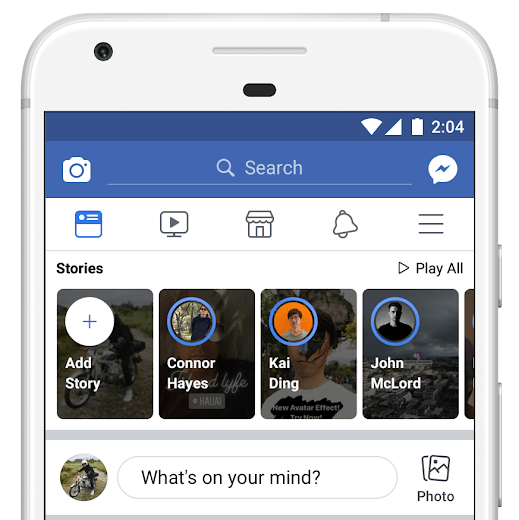
For all the jabs about Facebook stealing Stories from Snapchat, it’s working hard to differentiate. That’s in part because there’s not much left to copy, and because it’s largely succeeded in conquering the prodigal startup that refused to be acquired. Snapchat’s user count shrank last quarter to 188 million daily users.
Meanwhile, Facebook’s versions continue to grow. The Messenger Day brand was retired a year ago and now Stories posts to either the chat app or Facebook sync to both. After announcing in May that Facebook Stories had 150 million users, with Messenger citing 70 million last September, today the company revealed they have a combined 300 million daily users. The Middle East, Central Latin America and Southeast Asia, where people already use Facebook and Messenger most, are driving that rapid growth.

With the success of any product comes the mandate to monetize it. That push ended up pushing out the founders of Facebook acquisition WhatsApp, and encroachment on product decision-making did the same to Instagram’s founders who this week announced they were resigning.
Now the mandate has reached Facebook Stories, which today opened up to advertisers globally, and also started syndicating those ads into Stories within Messenger. Facebook is even running “Stories School” programs to teach ad execs the visual language of ephemerality since all four of its family of apps will monetize Stories with ads. WhatsApp will start to show ads in its Status version of Stories starting next year now that its founders that hated ads have left.
As sharing to Stories is predicted to surpass feed sharing in 2019, Facebook is counting on the ephemeral slideshows to sustain its ad revenue. Fears they wouldn’t lopped $120 billion off Facebook’s market cap this summer.
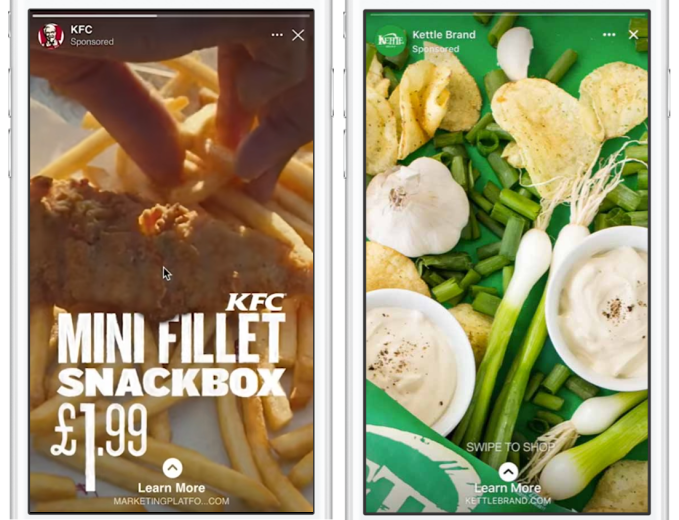
Facebook Stories ads open to all advertisers today
But to run ads you need viewers, and that will require responses to questions that have dogged Facebook Stories since its debut in early 2017: “Why do I need Stories here too when I already have Instagram Stories and WhatsApp Status?” Many find it annoying that Stories have infected every one of Facebook’s products.

Facebook user experience research manager Liz Keneski
The answer may be creativity. However, Facebook is taking a scientific approach to determining which creative tools to build. Liz Keneski is a user experience research manager at Facebook. She leads the investigative trips, internal testing and focus groups that shape Facebook’s products. Keneski laid out the different types of research Facebook employs to go from vague idea to polished launch:
Last year Facebook went on a foundational research expedition to India. Devanshi Bhandari, who works on the globalization, discovered that even in emerging markets where Snapchat never got popular, people already knew how to use Stories. “We’ve been kind of surprised to learn . . . Ephemeral sharing wasn’t as new to some people as we expected,” she tells me. It turns out there are regional Stories copycats around the globe.
As Bhandari dug deeper, she found that people wanted more creative tools, but not at the cost of speed. So Facebook began caching the Stories tray from your last visit so it’d still appear when you open Facebook Lite without having to wait for it to load. This week, Facebook will start offering creative tools like filters inside Facebook Lite Stories by enabling them server-side so users can do more than just upload unedited videos.
That trip to India ended up spawning whole new products. Bhandari noticed some users, especially women, weren’t comfortable showing their face in Stories. “People would sometimes put their thumb over the video camera but share the audio content,” she tells me. That led Facebook to build Audio Stories.
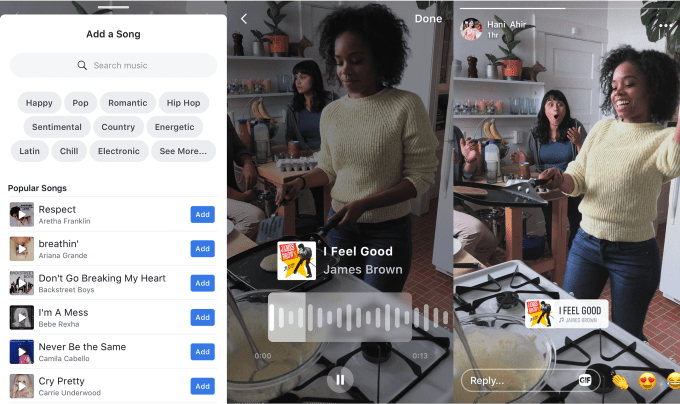
Facebook now lets U.S. users add music to Stories just like Instagram

Dantley Davis, Facebook Stories’ director of design
Back at Facebook headquarters in California, the design team runs exercises to distill their own visions of creative. “We have a phase of our design cycle where we ask the designers . . . to bring in their inspiration,” says Davis. That means everything from apps to movie clips to physical objects. Facebook determined that users needed better ways to express emotion through text. While it offers different fonts, from billboard to typewriter motifs, they couldn’t convey if someone is happy or sad. So now Davis reveals Facebook is building “kinetic text.” Users can select if they want to convey if text is supposed to be funny or happy or sad, and their words will appear stylized with movement to get that concept across.
But to make Stories truly Facebook-y, the team had to build them into all its products while solving problems rather than creating them. For example, birthday wall posts are one of the longest running emerging behaviors on the social network. But most people just post a thin, generic “happy birthday!” or “HBD” post, which can feel impersonal, even dystopic. So after announcing the idea in May, Facebook is now running Birthday Stories that encourage friends to submit a short video clip of well wishes instead of bland text.
Facebook recently launched Group and Event Stories, where members can collaborate by all contributing clips that show up in the Stories tray atop the News Feed. Now Facebook is going to start building its own version of Snapchat’s Our Stories. Facebook is now testing holiday-based collaborative Stories, starting with the Mid-Autumn Festival in Vietnam. Users can opt to post to this themed Story, and friends (but not the public) will see those clips combined.
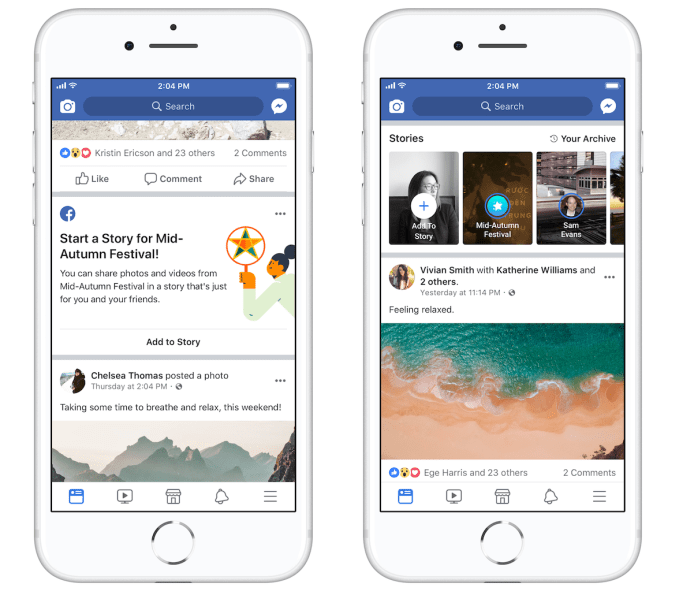
This is the final step of Facebook’s three-part plan to get people hooked on Stories, according to Facebook’s head of Stories, Rushabh Doshi. The idea is that first, Facebook has to get people a taste of Stories by spotlighting them atop the app as well as amidst the feed. Then it makes it easy for people to post their own Stories by offering simple creative tools. And finally, it wants to “Build Stories for what people expect out of Facebook.” That encompasses all the integrations of Stories across the product.

Rushabh Doshi, Facebook’s head of Stories
Still, the toughest nut to crack won’t be helping users figure out what to share but who to share to. Facebook Stories’ biggest disadvantage is that it’s built around an extremely broad social graph that includes not only friends but family, work colleagues and distant acquaintances. That can apply a chilling effect to sharing as people don’t feel comfortable posting silly, off-the-cuff or vulnerable Stories to such a wide audience.
Facebook has struggled with this problem in News Feed for over a decade. It ended up killing off its Friend List Feeds that let people select a subset of their friends and view a feed of just their posts because so few people were using them. Yet the problem remains rampant, and the invasion of parents and bosses has pushed users to Instagram, Snapchat and other younger apps. Unfortunately for now, Doshi says there are no Friend Lists or specific ways to keep Facebook Stories more private amongst friends. “To help people keep up with smaller groups, we’re focused on ways people are already connecting on Facebook, such as Group Stories and Event Stories” Doshi tells me. At least he says “We’re also looking at new ways people could share their stories with select groups of people.”
At 300 million daily users, Facebook Stories doesn’t deserve the “ghost town” label any more. People who were already accustomed to Stories elsewhere still see the feature as intrusive, interruptive and somewhat desperate. But with 2.2 billion total Facebookers, the company can be forced to focus on one-size-fits-all solutions. Yet if Facebook’s Blink testing app can produce must-use filters and effects, and collaborative Stories can unlock new forms of sharing, Facebook Stories could find its purpose.
Powered by WPeMatico
Earlier this year, Google announced its revamped Google Maps, which puts a stronger emphasis on discovery. Some of the features the company announced back then have already launched, including many of the promised discovery and exploration tools, but the one feature that was still missing was group planning. But you won’t have to wait much longer to collaboratively plan your outings with friends in Google Maps because today, these collaboration tools are finally launching.
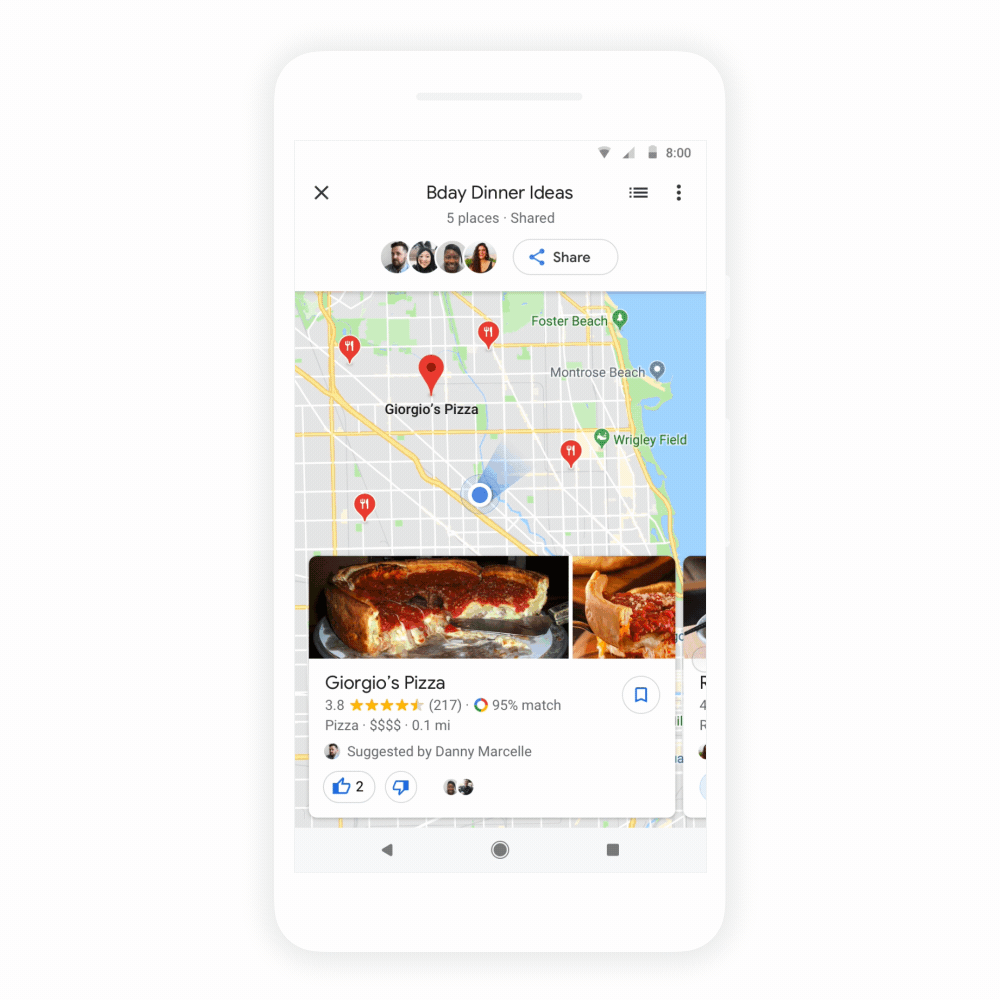
The basic problem Google is trying to solve here probably feels familiar to everybody who has ever tried to get a group of more than two people to decide on where to go for dinner — or any other outing, really. It usually takes way too many text messages to get everybody to agree.
Now, however, you’ll be able to create a list of places in Google Maps and then share those with your friends. And then, like in any good democracy, your friends can vote on where to go. Group members can also veto places by removing them from the shortlist and add other ones that they’d prefer (nobody said democracy was easy, right?).
Once you have created a list, you can share it just like any other link and your friends will be taken right to Google Maps on mobile or the web to join in the planning fun.
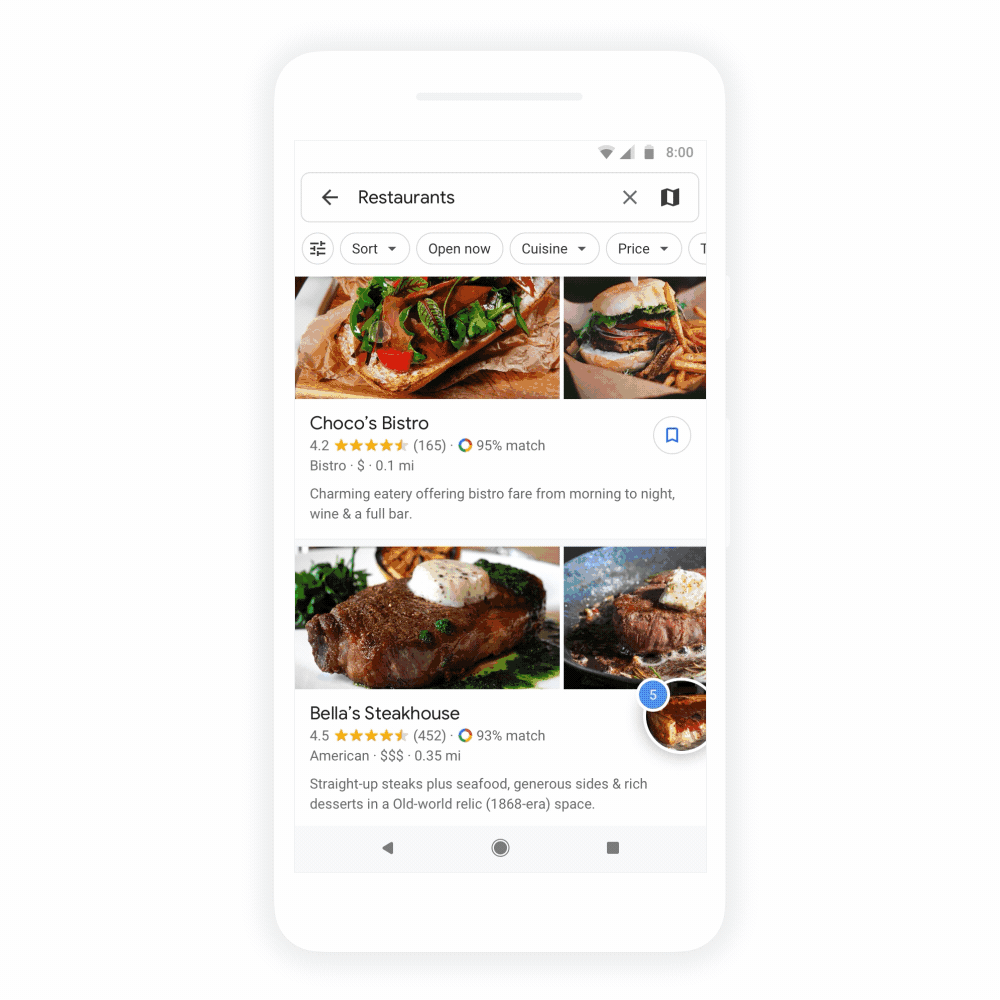
Powered by WPeMatico
Everyone’s favorite endless, serene snowboarding game just made the leap from mobile to the Mac App Store. Available now for $9.99, Alto’s Adventure for Mac is a desktop port of the side-scrolling snowscape game that’s won hearts and accolades since it first hit iOS in 2015.
Earlier this year, the team behind Alto’s Adventure introduced a second game, Alto’s Odyssey, which trades the first game’s snowy terrain for sand and sun while maintaining its charm. If you’ve already spent some time with Alto’s Odyssey, the Mac version of the classic is a good reason to circle back.
The game’s serene setting and blissed out music make Alto’s Adventure eminently replayable, even if you’ve already sunk tens of hours into lengthening your scarf in an infinite procedurally generated snowy world dotted with charming villages, dramatic slopes and many, many things to trip over.
If you’ve yet to dive into Alto’s Adventure, and we really recommend that you do, the Mac version is probably a good starting place. For everyone else, progress in the game syncs across devices through iCloud, so it’s a good excuse to push a little further into one of the most thoughtful, pleasant mobile game experiences to date.
And while you’re hanging out in the Mac App Store, don’t forget to update to Mojave — Apple’s latest desktop operating system is available now.
Powered by WPeMatico
See, snap, sale. In a rare partnership for Amazon, the commerce giant will help Snapchat challenge Instagram and Pinterest for social shopping supremacy. Today Snapchat announced it’s slowly rolling out a new visual product search feature, confirming TechCrunch’s July scoop about this project, codenamed “Eagle.”
Users can use Snapchat’s camera to scan a physical object or barcode, which brings up a card showing that item and similar ones along with their title, price, thumbnail image, average review score and Prime availability. When they tap on one, they’ll be sent to Amazon’s app or site to buy it. Snapchat determines if you’re scanning a song, QR Snapcode or object, and then Amazon’s machine vision tech recognizes logos, artwork, package covers or other unique identifying marks to find the product. It’s rolling out to a small percentage of U.S. users first before Snap considers other countries.
Snap refused to disclose any financial terms of the partnership. It could be earning a referral fee for each thing you buy from Amazon, or it could just be doing the legwork for free in exchange for added utility. A Snapchat spokesperson tells me the latter is the motivation (without ruling out the former), as Snapchat wants its camera to become the new cursor — your point of interface between the real and digital worlds.
Social commerce is heating up as Instagram launches Shopping tags in Stories and a dedicated Shopping channel in Explore, while Pinterest opens up Shop the Look pins and hits 250 million monthly users. The feature should mesh well with Snap’s young and culture-obsessed audience. In the U.S., its users are 20 percent more likely to have made a mobile purchase than non-users, and 60 percent more likely to make impulse purchases according to studies by Murphy Research and GfK.
The feature functions similarly to Pinterest’s Lens visual search tool. In the video demo above, you can see Snapchat identifying Under Armour’s HOVR shoe (amongst all its other models), and the barcode for CoverGirl’s clean matte liquid makeup. That matches our scoop based on code dug out of Snapchat’s Android app by TechCrunch tipster Ishan Agarwal. Snapchat’s shares popped three percent the day we published that scoop, and again this morning before falling back to half that gain.

The feature could prove useful for when you don’t know the name of the product you’re looking at, as with shoes. That could turn visual search into a new form of word-of-mouth marketing where every time an owner shows off a product, they’re effectively erecting a billboard for it. Eventually, visual search could help users shop across language barriers.
Amazon is clearly warming up to social partnerships, recognizing its inadequacy in that department. Along with being named Snapchat’s official search partner, it’s also going to be bringing Alexa voice control to Facebook’s Portal video chat screen, which is reportedly debuting this week according to Cheddar’s Alex Heath.
Snapchat could use the help. It’s now losing users and money, down from 191 million to 188 million daily active users last quarter while burning $353 million. Partnering instead of trying to build all its technology in-house could help reduce that financial loss, while added utility could aid with user growth. And if Snap can convince advertisers, they might pay to educate people on how to scan their products with Snapchat.
Snap keeps saying it wants to be a “Camera Company,” but it’s really an augmented reality software layer through which to see the world. The question will be whether it can change our behavior so that when we see something special, we interact with it through the camera, not just capture it.
Powered by WPeMatico
Instagram tells me Regramming, or the ability to instantly repost someone else’s feed post to your followers like a retweet, is “not happening”, not being built, and not being tested. And that’s good news for all Instagrammers. The denial comes after it initially issued a “no comment” to The Verge’s Casey Newton, who published that he’d seen screenshots of a native Instagram resharing sent to him by a source.
Regramming would be a fundamental shift in how Instagram works, not necessarily in terms of functionality, but in terms of the accepted norms of what and how to post. You could always screenshot, cite the original creator, and post. But Instagram has always been about sharing your window to the world — what you’ve lived and seen. Regramming would legitimize suddenly assuming someone else’s eyes.
The result would be that users couldn’t trust that when they follow someone, that’s whose vision would appear in their feed. Instagram would feel a lot more random and unpredictable. And it’d become more like its big brother Facebook whose News Feed has waned in popularity – susceptible to viral clickbait bullshit, vulnerable to foreign misinformation campaigns, and worst of all, impersonal.
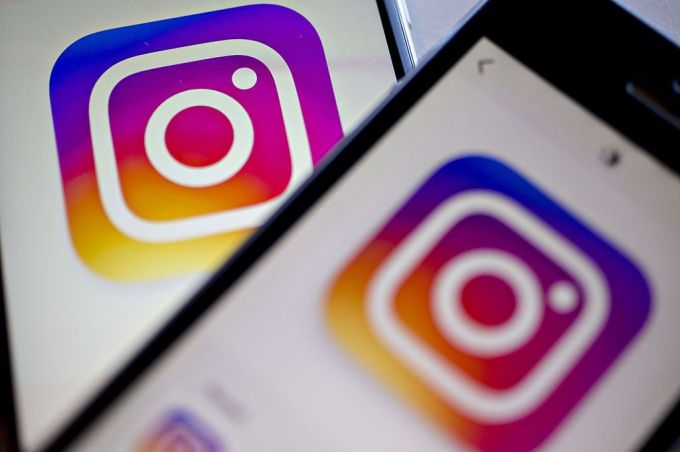
Photographer: Andrew Harrer/Bloomberg via Getty Images
Newton’s report suggested Instagram reposts would appear under the profile picture of the original sharer, and regrams could be regrammed once more in turn, showing a stack of both profile thumbnails of who previously shared it. That would at least prevent massive chains of reposts turning posts into all-consuming feed bombs.
Regramming could certainly widen what appears in your feed, which some might consider more interesting. It could spur growth by creating a much easier way for users to share in feed, especially if they don’t live a glamorous life themself. I can see a case for this being a feature for businesses only, which are already impersonal and act as curators. And Instagram’s algorithm could hide the least engaging regrams.
These benefits are why Instagram has internally considered building regramming for years. CEO Kevin Systrom told Wired last year “We debate the re-share thing a lot . . . But really that decision is about keeping your feed focused on the people you know rather than the people you know finding other stuff for you to see. And I think that is more of a testament of our focus on authenticity.”
See, right now, Instagram profiles are cohesive. You can easily get a feel for what someone posts and make an educated decision about whether to follow them from a quick glance at their grid. What they share reflects on them, so they’re cautious and deliberate. Everyone is putting on a show for Likes, so maybe it’s not quite ‘authentic’, but at least the content is personal. Regramming would make it impossible to tell what someone would post next, and put your feed at the mercy of their impulses without the requisite accountability. If they regram something lame, ugly, or annoying, it’s the original author who’d be blamed.
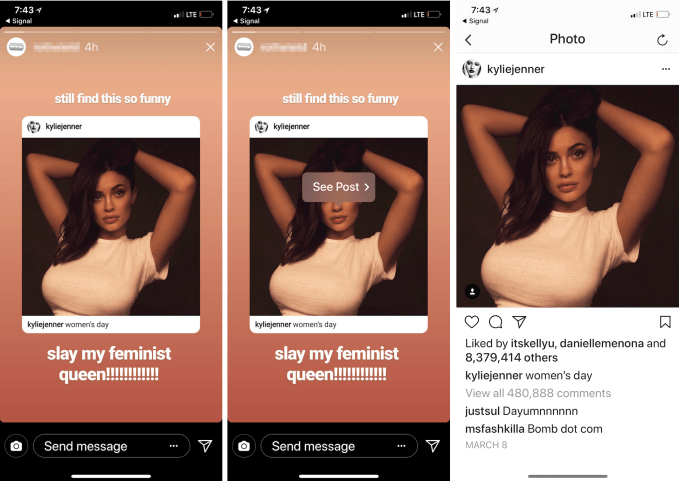
Instagram already offers a demand release valve in the form of re-sharing posts to your Story as stickers
Instagram already has a release valve for demand for regramming in the form of the ability to turn people’s public feed posts into Stickers you can paste into your Story. Launched in May, you can add your commentary, complimenting on dunking on the author. There, regrams are ephemeral, and your followers have to pull them out of their Stories tray rather than having them force fed via the feed. Effectively, you can reshare others’ content, but not make it a central facet of Instagram or emblem of your identity. And if you want to just make sure a few friends see something awesome you’ve discovered, you can send them people’s feed posts as Direct messages.
Making it much easier to repost to your feed instead of sharing something original could turn Instagram into an echo chamber. It’d turn Instagram even more into a popularity contest, with users jockeying for viral distribution and a chance to plug their SoundCloud mixtapes like on Twitter. Personal self-expression would be overshadowed even further by people playing to the peanut gallery. Businesses might get lazy rather than finding their own styles. If you want to discover something new and unexpected, there’s a whole Explore page full of it.
Newton is a great reporter, and I suspect the screenshots he saw were real, but I think Instagram should have given him the firm denial right away. My guess is that it wanted to give its standard no comment because if it always outright denies inaccurate rumors and speculation, that means journalists can assume they’re right when it does “no comment.”
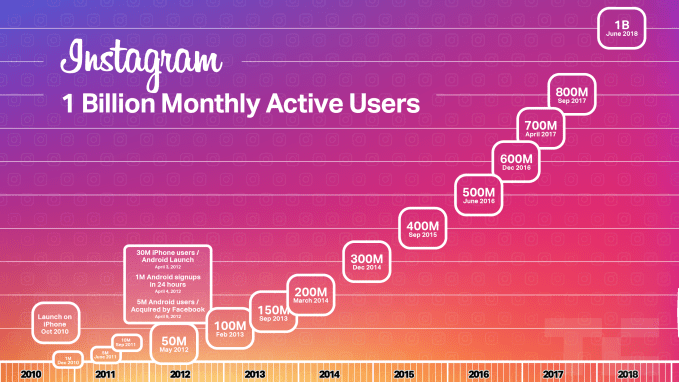
But once Newton published his report, backlash quickly mounted about how regramming could ruin Instagram. Rather than leaving users worried, confused, and constantly asking when the feature would launch and how it would work, the company decided to issue firm denials after the fact. It became worth diverging from its PR playbook. Maybe it had already chosen to scrap its regramming prototype, maybe the screenshots were just of an early mock-up never meant to be seriously considered, or maybe it hadn’t actually finalized that decision to abort until the public weighed in against the feature yesterday.
In any case, introducing regramming would risk an unforced error. The elemental switch from chronological to the algorithmic feed, while criticized, was critical to Instagram being able to show the best of the massive influx of content. Instagram would eventually break without it. There’s no corresponding urgency to fix what ain’t broke when it comes to not allowing regramming.
Instagram is already growing like crazy. It just hit a billion monthly users. Stories now has 400 million daily users, and that feature is growing six times faster than Snapchat as a whole. The app is utterly dominant in the photo and short video sharing world. Regramming would be an unnecessary gamble.
Powered by WPeMatico
Geofenced sharing, Quiz stickers, Stories Highlight stickers and a separate interface for adding hashtags to posts are amongst a slew of new features Instagram has prototyped or is now testing. The last one could finally #cure #the #hashtag #madness that’s infected many of Instagram’s 1 billion users, causing them desperately to fill up their captions with tagged words that make the feed tough to read in hopes of scoring a few extra views or followers. [Update: Instagram has also confirmed the launch of GIFs in Direct messaging. Details below.]
The pace of iteration at Instagram is staggering, and helping it to leave Snapchat in the dust. With Facebook’s deep pockets funding its product, design and engineering teams, Instagram is able to keep its app full of fresh toys to play with. Here’s a look at three prototypes, one test and one confirmed roll out from Instagram.
The feature isn’t released or even necessarily testing yet, and Instagram refused to comment on it. But frequent TechCrunch tipster and mobile researcher Jane Manchun Wong was able to dig the designated hashtag selector prototype out of the Instagram Android app’s code. It shows a dedicated “Add Hashtags” option underneath the caption composer and people tagger. Similar past discoveries by Wong have led to TechCrunch scoops about the eventual release of Instagram video calling, name tags, music stickers and more, though there’s always a chance Instagram scraps this feature before it ever launches.
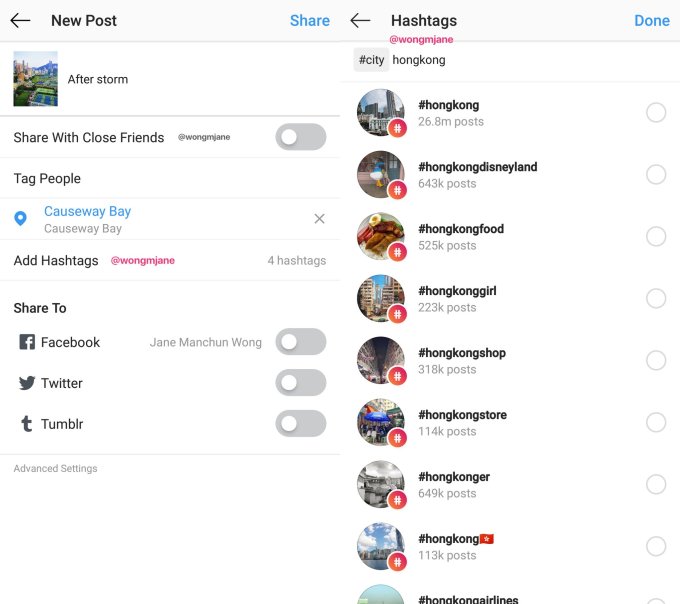
Disambiguating hashtags from captions could make adding them to posts less invasive and distracting, and thereby get more users doing it. That could in turn help Instagram tune its feed algorithm to show you more posts with hashtags you seem to care about, get more users following hashtags and allow it to better sort the Explore page with its new topic channels like Sports, Beauty and Shopping. But perhaps most importantly, it could just make Instagram less annoying. Everyone has that friend that slaps on so many hashtags that their captions become an incoherent mess.
Wong also dug out a powerful new feature that could help social media managers, businesses and pro creators reach the right audience. Instagram has prototyped a “Choose Locations” option for posts that lets you select from a list of countries where you want your post to be visible. Instagram declined to comment.
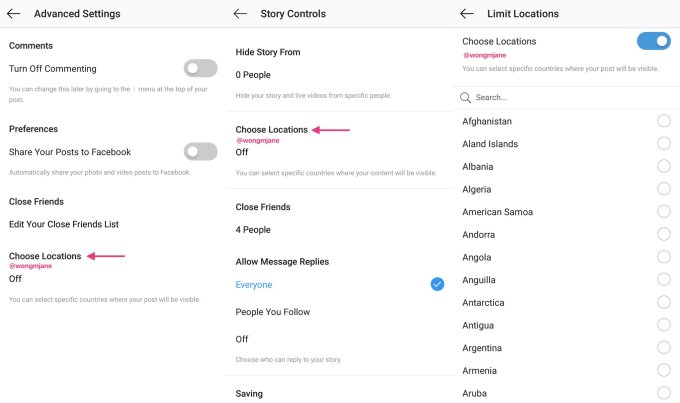
The geofencing feature might enable Instagrammers to design different content and captions for different countries and languages. Facebook has offered geofencing for posts for many years, and Instagram already offers ad targeting down to the ZIP code or mile radius. But if this location chooser launches for everyone’s posts, it could let people and professional accounts express their prismatic identity differently across the globe.
Instagram gave me a confirmation that this final find by Wong is officially in testing. It allows users to turn someone else’s Stories Highlight from their profile into a sticker to overlay on their own Story. It’s an extension of the Quote-tweet style feature Instagram started testing in March that lets you turn people’s public feed posts into Stories stickers so you can add your commentary — or dunk on someone dumb. Stories Highlight stickers could create a new path to virality for star creators who could convince their followers to re-share their Highlights and turn their friends into fellow fans.
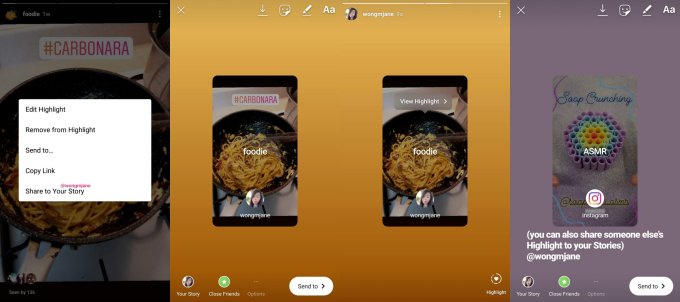
This prototype discovered by WABetaInfo‘s Twitter account allows users to ask a question in their Story and designate a correct answer. The Quiz sticker functions similarly to Instagram’s recently added Poll and Question stickers, but instead of tallying the results or letting you re-post someone’s answer, they’ll immediately see whether they guessed the right answer to your test. This ties into Instagram’s strategy to crush Snapchat by making its own Stories more interactive and turning the connection between fans and followers into a two-way street.
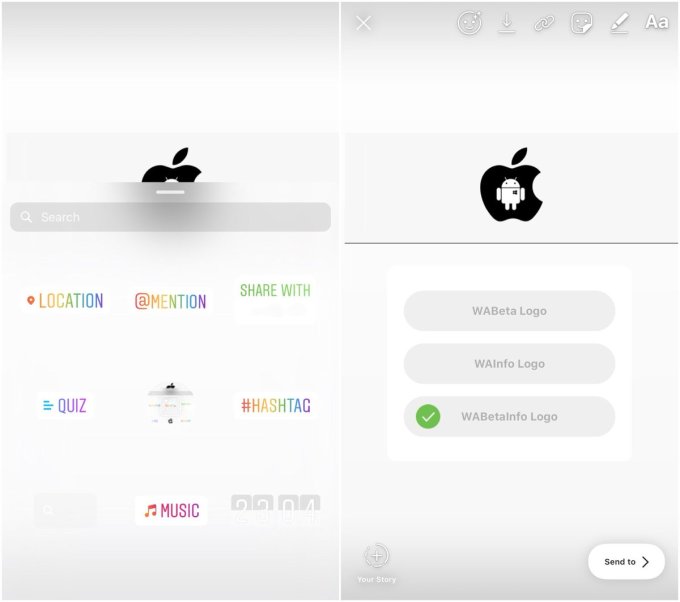
Instagram did confirm the launch of one new feature, tagging people in videos. TechCrunch spotted this last week and Instagram said it was testing, but upon our inquiry told us that it’s now fully rolled out. Video tagging could generate extra visits for Instagram as few people have the willpower to ignore a notification that they were named in a new piece of content. The feature could also help Instagram figure out who to show the videos to by allowing it to place them high in the feed of the best friends of people tagged.
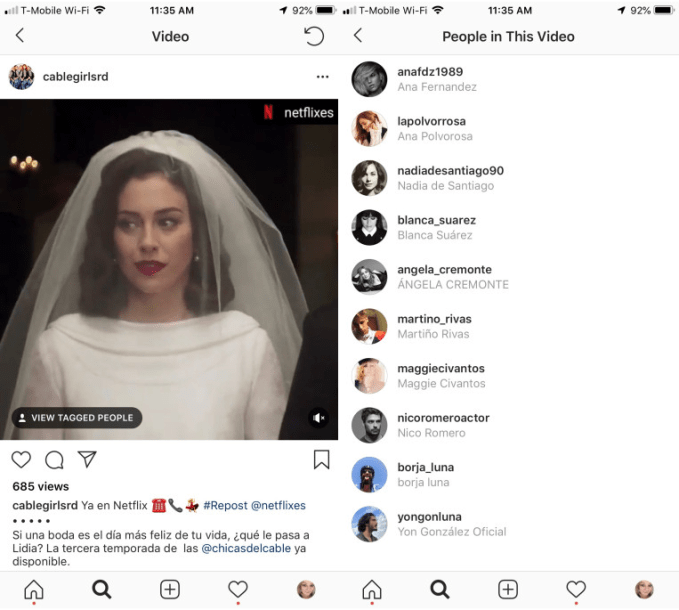
Today Instagram also confirmed that GIFs are rolling out to Direct messaging on iOS and Android, allowing you to search through a GIPHY-powered archive of animated images, or swipe through a trending GIFs section. You can also tap the “random” button after entering some keywords to get a surprise GIF added to your conversation. And after previously obscuring who actually made those GIFs, users can now tap and hold on to them to see the creator and other GIFs they’ve made. Instagram first offered GIFs as Stories stickers in January, and Wong had previously spotted them in Direct in Instagram’s code back in July. Clearly the racist GIF fiasco that led Instagram to temporarily shut down the GIF stickers hasn’t deterred it from expanding its partnership with GIPHY.
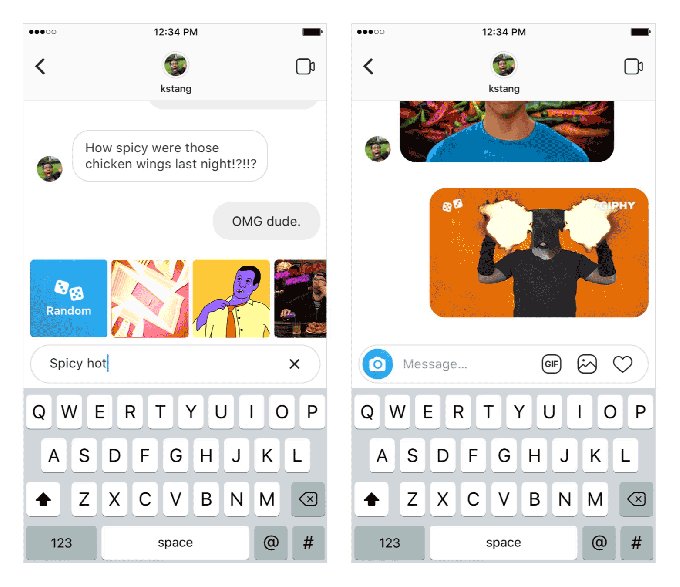
Combined, this flurry of new and potential features proves Instagram isn’t allowing its dominance to diminish its shipping schedule. It also demonstrates that Instagram VP of product Kevin Weil’s move to Facebook’s blockchain team and his replacement by former News Feed VP Adam Mosseri hasn’t disrupted the app’s brisk pace of innovation.
The jury is still out about whether Instagram’s biggest new initiatives will take off. IGTV is off to a slow start, but will need time to build a long-form video archive to rival YouTube. And we’ll have to wait and see if users grow addicted to Instagram Explore’s new Shopping channel. But constantly updating the app takes pressure off of any one feature to carry the weight of a billion people’s eyes. Who wants to build a direct competitor to something evolving this fast?
Powered by WPeMatico
Does deeper data produce perfect matches? Facebook is finally ready to find out, starting today with a country-wide test in Colombia of its new Dating feature. It’s centered around an algorithm-powered homescreen of Suggested romantic matches based on everything Facebook knows about you that other apps don’t. There’s no swiping and it’s not trying to look cool, but Facebook Dating is familiar and non-threatening enough to feel accessible to Facebook’s broad array of single users.
Originally announced at F8 in May, Facebook has hammered out details like limiting users to expressing interest in a maximum of 100 people per day, spotlighting personal questions as well as photos, and defaulting to show you friends-of-friends as well as strangers unless you only want to see people with no mutual connections. If the test goes well, expect Facebook to roll Dating out to more countries shortly as the social network pushes its mission to create meaningful connections and the perception that it can be a force of good.
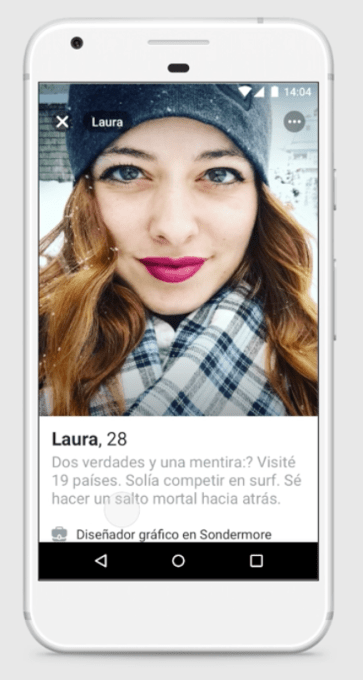 “The goal of the team is to make Facebook simply the best place to start a relationship online” Facebook Dating’s product manager Nathan Sharp told me during an expansive interview about the company’s strategy and how it chose to diverge from the top dating apps. For starters, it’s not trying to compete with Tinder for where you find hookups by swiping through infinite options, but instead beat eHarmony, Hinge, and OKCupid at finding you a life partner. And it’s all about privacy, from its opt-in nature to how it’s almost entirely siloed from Facebook though lives within the same app.
“The goal of the team is to make Facebook simply the best place to start a relationship online” Facebook Dating’s product manager Nathan Sharp told me during an expansive interview about the company’s strategy and how it chose to diverge from the top dating apps. For starters, it’s not trying to compete with Tinder for where you find hookups by swiping through infinite options, but instead beat eHarmony, Hinge, and OKCupid at finding you a life partner. And it’s all about privacy, from its opt-in nature to how it’s almost entirely siloed from Facebook though lives within the same app.
“We wanted to make a product that encouraged people to remember that there are people behind the profiles and the cards that they’re seeing. We wanted a system that emphasizes consideration over impulse. We want you to consider more than that person’s profile photo.”
Though Facebook could surely earn a ton off of Facebook Dating if it gets popular, for now there are no plans to monetize it with ads or premium subscriptions to bonus features. But as Facebook strives to stay relevant beyond the aging News Feed and combat its branding crisis, there are plenty of incentives for it to find us a significant other.
“Dating is something we’ve seen on the platform since the earliest days. We know there are 200 million people who list themselves as single” says Sharp. He’s married himself but says with a laugh that Facebook Dating “is definitely a young and single team.” Back in 2004, online dating still had a sleazy reputation. But now that over a third of U.S. marriages start online, and Facebook has had time to identify the pitfalls stumbled into by other dating apps, it’s ready to pucker up.
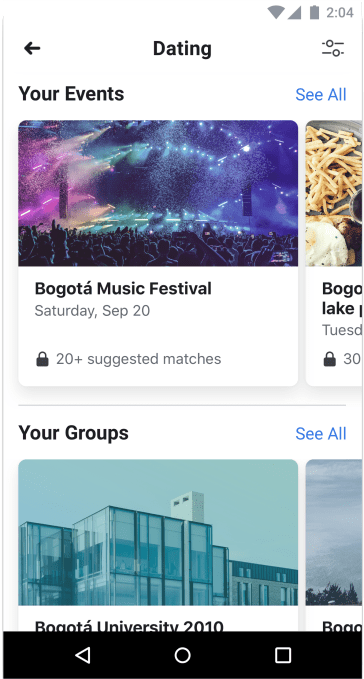 The basic flow is that users 18 and up (or the local ‘Adult’ equivalent) will see a notice atop their News Feed inviting them to try Facebook Dating when it comes to their country, and they’ll see a shortcut in their bookmarks menu. For now Facebook Dating is mobile-only, and will is bundled into the social network’s main iOS and Android apps.
The basic flow is that users 18 and up (or the local ‘Adult’ equivalent) will see a notice atop their News Feed inviting them to try Facebook Dating when it comes to their country, and they’ll see a shortcut in their bookmarks menu. For now Facebook Dating is mobile-only, and will is bundled into the social network’s main iOS and Android apps.
They’ll opt in, verify their city using their phone’s location services, and decide whether to add details like a free-form bio, workplace, education, religion, height, and if they have children. Facebook offers non-binary genders and sexual orientations. To fill out their profile, they’ll choose up to a dozen photos they upload, are tagged in, previously posted to Facebook, or cross-posted from Instagram as well as answer up to 20 questions about their personality such as “What does your perfect day look like?” or “What song always makes you sing along? How loud?”
Users can select to filter their matches by distance (up to a maximum radius of 100 kilometers), if they have children, religion, height, and age. They may then browse through the homescreen’s Suggested matches list, or they can choose to ‘Unlock’ Events and Groups they’re part of to see people from those who’ve done the same. Anyone you’ve blocked on Facebook won’t show up, though unfriended exs might. To see the next person, they either have to say they’re not interested, or choose a photo or question from the person’s profile and send them a message related to it (or at least they’re supposed to), and afterwards the sender can’t see the recipient any more.
The text and emoji-only messages go through a special Facebook Dating chat section, not Messenger, and land in the recipient’s Interested tab with no read receipts. If they reply, the chat moves to both people’s Conversations tab. From there they can decide to connect elsewhere online or meet up in person.
Sharp admits that “The moment you try to control the system you may have some unexpected behaviors occur there”. Facebook thought ahead so you can’t message photos (dick pics), you’re supposed to tie your message to a piece of their content (fewer generic pick-up lines), and you can’t follow up with people who don’t respond to you (stalking). But the company plans to stay vigilant in case unexpected forms of abuse or privacy issues emerge. Overall, Facebook managed to pull off Dating without any glaring privacy snafus or other obvious missteps.
Starting today, users in Colombia will be able to create a Facebook Dating profile, but the company won’t start serving matches until there are enough sign ups. Sharp tells me “we don’t expect it to take months.” But why Colombia? He says it’s because much of South America has culturally accepted online dating, it has a sizeable population of 30 million monthly active Facebook users, and the social network can track data out of a few discrete metropolitan areas.
It also likely limits the prying eyes of journalists hunting for Facebook policy or privacy screw-ups, and eliminates the risk of disrupting its advertising in more lucrative markets like the U.S. It’s hard to forget that Facebook screwed up news consumption in Sri Lanka, Bolivia, Slovakia, Serbia, Guatemala and Cambodia last year by banishing all news publishers to a separate feed — effectively depriving the populations of important information. There are consequences to its experiments.
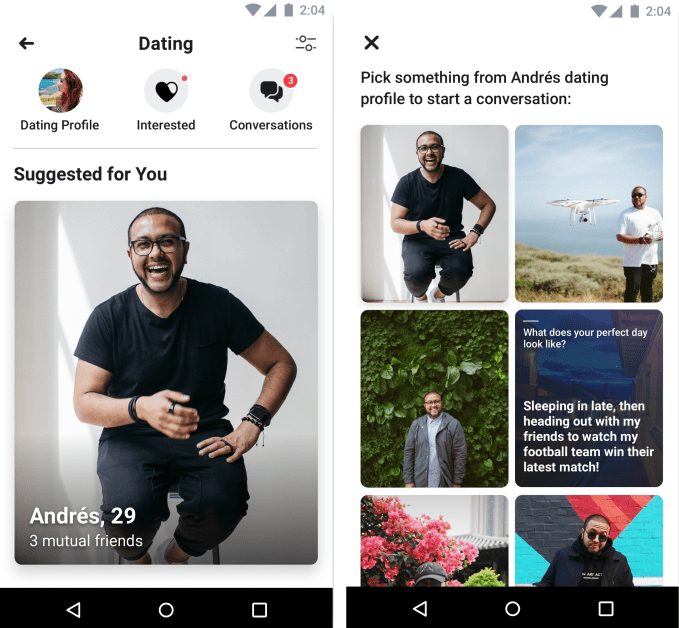
There are a lot of other ‘whys’ to how Facebook Dating was built. Sharp ran me through the decision making process his team undertook to turn Facebook Dating from a concept into a concrete product. Here I’ll run through its rules and features while explaining the philosophy behind them:

A prototype of Facebook Dating’s onboarding flow
The end result is an online dating product that maximizes convenience, both in where it’s available and how much hunting you have to do by yourself. It’s distinctly one-size-fits-all to the point that it risks being seen as universally embarassing. Luckily only other Dating users can tell if you’re on it and there’s no way to search for someone specific, but there’s still the threat of humilating screenshots surfacing. It will be fascinating to see how Facebook Dating’s marketing strategy and style develops.
 Facebook’s real advantage in this market will be its near-bottomless trove of personal data about all of us. It could analyze trends in characteristics of people who list themselves in a relationship together or what kinds of people respond to what kinds of people’s friend requests or messages. For matching, it could pair people who check in to similar locations or whose GPS paths cross, singles who Like similar bands or restaurants, or those who watch the same kinds of viral videos or share links from the same news outlet. Apps like Tinder can only scratch the surface with partnerships like its one with Foursquare to power its new Places matches. Turning all this info into insights about who’d like who will be a massive challenge for Facebook’s data scientists.
Facebook’s real advantage in this market will be its near-bottomless trove of personal data about all of us. It could analyze trends in characteristics of people who list themselves in a relationship together or what kinds of people respond to what kinds of people’s friend requests or messages. For matching, it could pair people who check in to similar locations or whose GPS paths cross, singles who Like similar bands or restaurants, or those who watch the same kinds of viral videos or share links from the same news outlet. Apps like Tinder can only scratch the surface with partnerships like its one with Foursquare to power its new Places matches. Turning all this info into insights about who’d like who will be a massive challenge for Facebook’s data scientists.
The big question remains how far Facebook will go to making Dating a hit. The feature could live or die by whether Facebook is willing to constantly nag its single users to sign-up. Without the gamification of swiping for fun, Facebook Dating will have to rely on its utility. The company is in a precarious time for its brand, and may have trouble getting people to trust it with an even more sensitive part of their lives.
“As all the events of the past year have unfolded, it’s only underscored the importance of privacy” Sharp concludes. No one wants their dating profile ending up Cambridge Analytica’d. But if analyzing your every Like and link gives Facebook uncanny matching accuracy, word could travel fast if it’s how people find their soul-mates.
Powered by WPeMatico